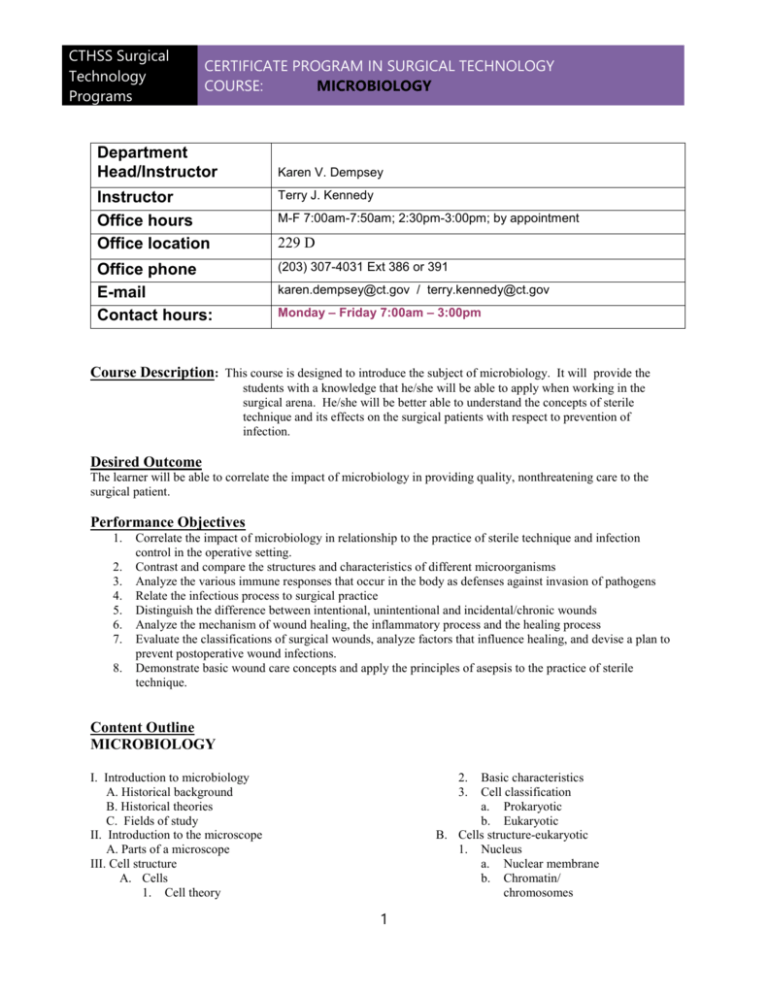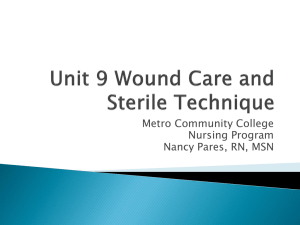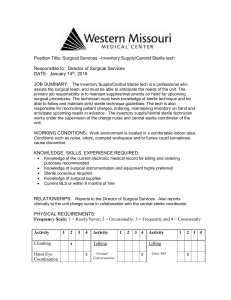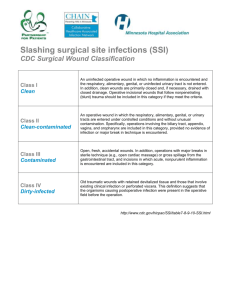Certificate Program in surgical technology
advertisement

CTHSS Surgical Technology Programs CERTIFICATE PROGRAM IN SURGICAL TECHNOLOGY COURSE: MICROBIOLOGY Department Head/Instructor Karen V. Dempsey Instructor Office hours Office location Terry J. Kennedy Office phone E-mail Contact hours: (203) 307-4031 Ext 386 or 391 M-F 7:00am-7:50am; 2:30pm-3:00pm; by appointment 229 D karen.dempsey@ct.gov / terry.kennedy@ct.gov Monday – Friday 7:00am – 3:00pm Course Description: This course is designed to introduce the subject of microbiology. It will provide the students with a knowledge that he/she will be able to apply when working in the surgical arena. He/she will be better able to understand the concepts of sterile technique and its effects on the surgical patients with respect to prevention of infection. Desired Outcome The learner will be able to correlate the impact of microbiology in providing quality, nonthreatening care to the surgical patient. Performance Objectives 1. 2. 3. 4. 5. 6. 7. 8. Correlate the impact of microbiology in relationship to the practice of sterile technique and infection control in the operative setting. Contrast and compare the structures and characteristics of different microorganisms Analyze the various immune responses that occur in the body as defenses against invasion of pathogens Relate the infectious process to surgical practice Distinguish the difference between intentional, unintentional and incidental/chronic wounds Analyze the mechanism of wound healing, the inflammatory process and the healing process Evaluate the classifications of surgical wounds, analyze factors that influence healing, and devise a plan to prevent postoperative wound infections. Demonstrate basic wound care concepts and apply the principles of asepsis to the practice of sterile technique. Content Outline MICROBIOLOGY I. Introduction to microbiology A. Historical background B. Historical theories C. Fields of study II. Introduction to the microscope A. Parts of a microscope III. Cell structure A. Cells 1. Cell theory 2. 3. Basic characteristics Cell classification a. Prokaryotic b. Eukaryotic B. Cells structure-eukaryotic 1. Nucleus a. Nuclear membrane b. Chromatin/ chromosomes 1 CTHSS Surgical Technology Programs CERTIFICATE PROGRAM IN SURGICAL TECHNOLOGY COURSE: MICROBIOLOGY 2. Cell membrane 3. Cytoplasm 4. Nucleolus 5. Ribosomes 6. Endoplasmic reticulum 7. Mitochondria 8. Golgi apparatus 9. Lysosomes 10. Pinocytotic vesicles 11. Centrioles 12. Microtubules/ microfilaments C. Cell structure – prokaryotic 1. Cell envelope a. Capsule or slime layer b. Cell wall c. Cytoplasmic membrane 2. Mesosomes a. Nucleoid b. Plasmids c. Ribosomes d. Flagella e. Pili/fimbraie IV. Fluid movements concepts A. Diffusion B. Osmosis C. Filtration D. Active transport E. Phagocytosis F. Pinocytosis V. Microorganisms A. Classification of organisms 1. Kingdom 2. 3. 4. 5. 6. 7. a. Plantae b. Animalia c. Fungi d. Protists 5. 6. 7. Rickettsiae Viruses Prions C. Characteristics of algae 1. Morphology 2. Occurrence 3. Relationship to humans 4. Uses D. Characteristics of protozoa 1. Morphology 2. Nutrition 3. Classification according to locomotion 4. Pathogenicity 5. Occurrence in human 6. Occurrence in nature E. Characteristics of fungi (yeasts/molds) 1. Morphology 2. Nutrition 3. Reproduction methods 4. Pathogenicity 5. Occurrence in humans 6. Occurrence in nature F. Characteristics of bacteria 1. Morphology and grouping 2. Staining 3. Motility 4. Colonization 5. Nutrition 6. Biochemical activities 7. Pathogenicity 8. Occurrence in humans 9. Occurrence in nature G. Characteristics of rickettsiae 1. Morphology 2. Staining 3. Transmission 4. Pathogenicity 5. Occurrence in humans 6. Occurrence in nature H. Characteristics of viruses 1. Classification 2. Morphology 3. Differentiation from other cells 4. Lysogenic cycle 5. Bacteriophages 6. Genetic changes 7. Transmission 8. Pahtogenicity 9. Occurrence in humans 10. Occurrence in nature e. Monera Phylum Class Order Family Genus Species B. Specific classes of microorganisms 1. Algae 2. Protozoa 3. Fungi (yeasts and molds) 4. Bacteria 2 CTHSS Surgical Technology Programs CERTIFICATE PROGRAM IN SURGICAL TECHNOLOGY COURSE: MICROBIOLOGY A. Characterisitics of prions 1. Classification 2. Morphology 3. Pathogenicity 4. Occurrence in human 4. Pseudomonas aeruginosa 5. Haemophilus 6. Mycobacterium tuberculosis 7. Hemolytic Streptococcus, alpha type 8. Nonhemolytic Streptococcus 9. Clostridium perfringens 10. Clostridium tetani 11. Bateroides species 12. Candida albicans 13. Hepatitis A virus 14. Hepatitis B virus 15. Hepatitis C virus 16. Hepatitis D virus 17. Human Immuno-deficiency Virus (HIV) 18. Human papillomavirus (HPV) 19. Prion disease VI. Immunolgic defense mechanism A. Immunology 1. Antigen 2. Antibody/immunoglobulin 3. Antigen-antibody reaction B. Immune response 1. Lag phase 2. Primary response 3. Secondary response C. Acquired immunity 1. Active a. Natural b. Artificial 2. Passive a. Natural b. Artificial D. Vaccines 1. Nonpathogenic strains 2. Closely related microorganisms 3. Attenuated living pathogens 4. Killed pathogens 5. Extracts of pathogens 5. Occurrence in nature B. Common microbes and their diseases 1. Neisseria gonorrhoeae 2. Neisseria menigitidis 3. Escherichia coli 6. Toxoids 7. Recombinant DNA VII. Hypersensitivity A. Immediate B. Delayed C. Autoimmunity D. Terminology 1. Allergen 2. Allergy 3. Localized allergic reaction 4. Anaphylactic shock VIII. Process of infections A. Terminology 1. Abscess 2. Acute infection 3. Aerobic 4. Anaerobic 5. Antibiotic 6. Antibody 7. Antigen 8. Antisepsis 9. Antiseptic 10. Bacteremia 11. Bacteriocide 12. Bacteriostasis 13. Bioburden 14. Carrier 15. Chronic infection 16. Chronic/permanent 17. Community-acquired infection 18. Contaminated 19. Contamination 20. Convalescent carrier 21. Cross-contamination 22. Cross-infection 23. Culture 24. Disease 25. Disinfectant 3 CTHSS Surgical Technology Programs 26. 27. 28. 29. 30. 31. 32. 33. 34. 35. 36. 37. 38. 39. 40. 41. 42. 43. 44. 45. 46. 47. 48. 49. 50. 51. 52. 53. 54. 55. 56. 57. 58. 59. 60. 61. 62. 63. 64. 65. 66. 67. 68. CERTIFICATE PROGRAM IN SURGICAL TECHNOLOGY COURSE: MICROBIOLOGY Disinfection Droplet Endogenous source Endotoxin Exogenous source Exotoxin Falcultative Flora Fomite Host Infection Infectious agent Inflammation Local infection Necrotic Nonsterile Nosocomal infection Obligatory Parasite Pathogens Phagocytosis Primary infection Principles of asepsis Pus Reservoir Resident microorganism Saprophyte Secondary infection Sepsis Septicemia Source Spore Sterile Sterile field Sterile technique Sterilization Sterilizer Superinfection Suppuration Surgically clean Systemic infection Toxin Transient microorganism 69. Transitory/temporary 70. Vector B. Pathogenicity 1. Aggressiveness and virulence of the pathogen 2. Size and composition of the microbe population 3. Physical environment 4. Susceptibility of the host C. Inflammatory process 1. Signs of inflammation a. Redness b. Heat c. Swelling d. Pain 2. Physiology a. Increased blood supply to the site and dilatation of blood vessels= heat and increased #WBCS + pphagocytosis b. Edema, swelling from fluid formation = pain c. Accumulation of dead/living microbes + WBCS = pus 3. Infection a. Invasion b. Localization c. Resolution IX. Wound Healing A. Historical background B. Definitions 1. Adhesions 2. Dehiscence 3. Dead space 4. Debridement 5. Granuloma 6. Collagen 7. Evisceration 8. Hemostasis 9. Scar 10. Necrosis 11. Trauma 12. Hematoma 4 CTHSS Surgical Technology Programs C. D. E. F. G. H. CERTIFICATE PROGRAM IN SURGICAL TECHNOLOGY COURSE: MICROBIOLOGY 13. Keloid 14. Edema 15. Seroma 16. Exudates 17. Granulation tissue 18. Contracture 19. Gangrene 20. Serosanguinous Structure and function of the skin Types of wounds 1. Intentional a. Surgical cite incision/excision b. Chemical wounds c. Occlusion banding 2. Unintentional wounds 3. Traumatic injuries a. Closed wounds b. Open wounds c. Simple wounds d. Clean wounds e. Complicated wounds f. Delayed full-thickness injury g. Contaminated wounds 4. Incidental wounds a. Pressure sores b. Ulcers Mechanism of wound healing 1. First intention/primary union 2. Second intention/granulation 3. Third intention/delayed primary closure Inflammatory process 1. Pain 2. Heat 3. Swelling 4. Redness Healing process 1. Fibrinogen 2. Fibroblasts 3. Collagen 4. Network of fibers 5. Scar tissue Stages of wound healing 1. Lag phase/inflammatory response phase 2. Proliferation phase 3. Maturation or differentiation phase I. Factors influencing healing 1. Physical condition 2. General health (1) Smoking (2) Circulatory status (3) Age (4) Nutritional status (5) Obesity (6) Inflammatory and immune responses a. Related disease processes (1) Hematology (2) Fluid and electrolyte balance (3) Immunosuppression (4) Drug therapy (5) Radiation (6) Acute/chronic disease process (7) Co-morbidity 3. Surgical technique a. Sterile technique b. Tissue handling c. Methods of hemostasis d. Wound security e. Tissue approximation J. Complications 1. Hematoma/seroma 2. Infection 3. Wound disruption a. Dehiscence b. Herniation c. Evisceration 4. Hemorrhage 5. Sinus tract formation 4. Fistula 6. Scar/surgical cicatrix/keloid 7. Adhesion 8. Suture complications K. Surgical site infection (SSI) 1. Incisional infection 2. Deep wound infection 3. Noscomial infections 5 CTHSS Surgical Technology Programs CERTIFICATE PROGRAM IN SURGICAL TECHNOLOGY COURSE: MICROBIOLOGY a. Endogenous infection b. Exogenous infection L. Prevention of wound infections 1. Reduce sources of contamination 2. Standard precautions 3. Principles of asepsis and practice of sterile technique 4. Meticulous technique and wound closure 5. Control endogenous infection 6. Tissue perfusion 7. Antibiotic therapy 8. Wound drains M. Basic wound care procedure 1. Standard precautions 2. Sterile technique a. Sterile supplies b. Sterile gloves 3. Physician’s orders 4. Procedural steps a. Old dressings removed b. Sterile gloves donned c. Wound cleansed/debridement (1) Sterile NS (2) Antiseptics (3) Wound cleaned first (4) Wound dressing N. Wound classifications a. Class I – Clean b. Class II – Clean/ Contaminated c. Class III – Contaminated d. Class IV – Dirty/Infected e. Examples of surgical procedures that fall into each category Course Evaluation: Exams, quizzes, lab practical, research papers Course Grade: The course grade for students in Health Education will be weighted according to the following activities and assignments: 20 % Dialogue Center: This category include broad based assessment of class discussion and participation as well as oral presentations (Oral or written) and role playing. 10 % Homework: This category may include but is not limited to the following activities: question and answers based on reading, note-taking, graphic organizers, and homework reader responses. 60 % Course Assessments and/or Written Assignments: This category may include but is not limited to the following informal (writing samples, journals, performance assessments, role playing, projects, discussion, in class assignments) and formal assessments (end of course assessments). 10 % Common Assessment: Common assessments given at the end of this course will count 10% of the total grade. All students must achieve a grade of at least 75% on the common assessment. Students who retake the common assessment will receive an average of the two grades. Make-ups due to absences will follow the policies of both attendance and grading. Texts for this Course Surgical Technology For the Surgical Technologist Caruthers 6 978-1-4180-5168-6 CTHSS Surgical Technology Programs CERTIFICATE PROGRAM IN SURGICAL TECHNOLOGY COURSE: MICROBIOLOGY Delmar Fundamentals of Anatomy and Physiology Rizzo 978-1-435-43871-2 Medical Terminology Systems Gylys/Wedding 978-0-8036-2145-9 7




